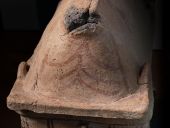...In de bo(o)tanische tuin
De bloemen op de korte zijde van de larnax lijken nogal op een schematische weergave van de typische ‘Minoïsche bloem’, die meestal bestaat uit een stengel, twee bladen, een stamper en meeldraad. Op deze larnax heeft de bloem slechts een omgekeerde, gehaakte meeldraad en drie paar bladen. De meeldraad is het geslachtsorgaan van de bloem dat pollen produceert en daarom kan de bloem op de larnax staan voor vruchtbaarheid en wedergeboorte. Het motief komt veel voor in Minoïsche kunst, niet alleen op grafobjecten maar ook op aardewerk en fresco’s. De rechte lijnen daarentegen geven blijk van het paneeldesign dat op de oorspronkelijke houten versie te zien was.
Als de maritieme beelden de scenes op het land verbeelden, zoals de bloemen op de korte zijde van deze larnax, kan dat gezien worden als een voorstelling van het hiernamaals. Deze religieuze symbolen duiden ook op de heiligheid van de kist en zijn tevens bedoeld om boosdoeners buiten te houden.

](https://micrio.thingsthattalk.net/PcjLu/views/max/128x128.jpg)